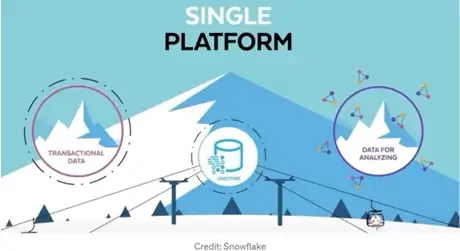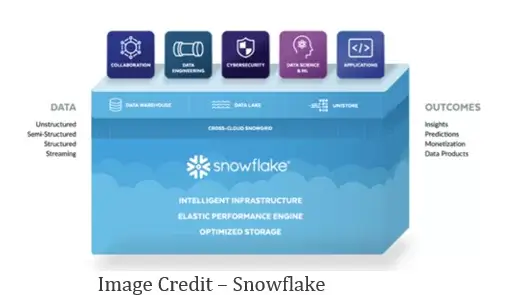Unveiling Insights: A Recap of Key Takeaways from Snowflake Summit 2022
Snowflake Summit 2022: The Future of Cloud Data Management Unpacked
Extracting Value: Essential Learnings from Snowflake Summit 2022
Summary
What a difference a couple of years make! This year’s Snowflake Summit brought with it numerous platform improvements, additional workloads, services and capabilities.
Focus continues to be on three key areas:
- Improving the overall performance of the platform
- strengthening governance
- extending the reach and types of data it can cover
Snowflake emphasized the importance of focusing on verticals, such as Financial Services and Health Sciences, and stressing the importance of supporting solutions that align to strategic initiatives in these verticals.

Further, Snowflake is focusing on enabling customers with more access to data via Data Marketplace, including the further enablement of advanced insights and data monetization. They are also introducing new ways to perform application development directly in the Snowflake platform, via newly announced and introduced Native Application Framework, Python and Java on Snowpark, and by way of Low-code application development via Streamlit.
Innovations in Cloud Data Management: Highlights from Snowflake Summit 2022
Transforming Analytics: Key Announcements and Trends from Snowflake’s Premier Event
Leveraging Data for Success: Lessons Learned from Snowflake Summit 2022
Navigating the Future: How Snowflake’s Platform is Shaping the Data Landscape
Snowflake Unistore
Snowflake announced the launch of Unistore, a new workload for its data cloud, that is currently available in private preview. The solution extends the capabilities of the platform and provides enterprises with a way to do away with the practice of storing traditional and analytical data across different, siloed systems.

Organizations have traditionally kept their analytical and transactional datasets separate. The practice has worked, but also increases governance complexity and constrains the timeliness of related actionable data. Unistore solves this problem by enabling organizations to leverage and manage the lifecycle of both transactional and analytical datasets in a single location.
The workload includes new hybrid tables, which provide fast single-row operations and enable enterprises to build transactional business applications directly on Snowflake. Teams can even perform quick analytics on hybrid tables to get insights from their transactional data or join them with other existing Snowflake tables for a holistic view of all data.
Breaking Down Snowflake’s Latest Offerings: What You Need to Know
Data Governance and Security: Insights from Snowflake Summit 2022 Sessions
Harnessing the Power of Snowflake: Case Studies and Success Stories
From Insights to Action: Implementing Key Takeaways from Snowflake Summit 2022
Take away: Transactional databases in Snowflake is new and will drive more Snowflake growth beyond EDW and analytics workloads.
Native Application Framework
The next big thing coming from Snowflake’s summit is the announcement of Native Application Framework to help enterprises build data applications and share them on the marketplace and monetize them as well.
Take away: The Native Application Framework is a data development disruptor, addressing all challenges which come with selling Data Applications, like security, governance, infrastructure, etc. from within the Snowflake Marketplace.
Expanded Python Support on Snowpark
Snowflake’s developer framework, Snowpark, is adding Python support. Snowpark is a new developer experience that provides an intuitive API for querying and processing data in a data pipeline. Using this library, you can build applications that process data in Snowflake without moving data to the system where your application code runs. This addition will make Python’s rich ecosystem of open-source packages and libraries seamlessly accessible in the Snowflake Data Cloud, further improving the programming environment it provides to build scalable pipelines, applications, and machine learning (ML) workflows.
Take away: Native Python support in Snowpark is a potential game changer, enabling Data Scientist to develop models and run their code on the same platform as where the data resides. This will surely drive additional users and data workloads to Snowflake.
Snowflake and Streamlit will be natively integrated. Data applications can be built using Python on Snowflake Snowsight as a first class object called ‘Streamlit’ which runs natively in Snowflake.
Improved data access
To improve enterprise users’ access to data, Snowflake also introduced several innovations, including Snowpipe Streaming. The feature will enable serverless ingestion of streaming data, and is set to be complemented with Materialized Tables, designed to simplify the transformation of streaming data.
In addition, the company announced Iceberg Tables to enable users to work with Apache Iceberg, a popular open table format, in external storage and the ability to manage, classify, tag and govern on-prem data. The latter will be useful in cases when data has not been moved to the cloud or is yet to be moved.
On-prem Data Access using External Tables
Connecting to On-premises Data using storage compatible with the Amazon S3 REST API (Dell ECS, PureStorage or MinIO). This storage can be used as an External Table in Snowflake. This will make it easier to load your On-premises Data into Snowflake.
Account Replication
Snowflake supports data replication between the databases for fail over and disaster recovery and for variety of reasons, they announced to expand the support at account level, which includes not just database replication but also users, roles and data pipelines.
Cost Governance
To extend resource monitoring, Snowflake announced new features to create Resource Groups and set budgets. Two features to control spending on budgets at granular levels.
Update of Snowflake Win Themes and How to Communicate “Why Snowflake”:

- Snowflake was built from scratch for the Cloud, which enables many of the following key value points
- Unlimited resource scale for compute and storage
- Elasticity – scale up and down based on resource needs
- With Elasticity you only pay for what you use. You don’t have to maintain expensive infrastructure for the highest peak usage times.
- Snowflake allows for structured and unstructured data
- One source of truth from Data Lakes to Data Warehouses allows for data sharing to segmented users, partners, customers without duplication of data
- Unmatched data security, including row-level security
- Can handle “ALL WORKLOADS” – Machine Learning, Traditional Data Workloads(OLTP), Data Warehouse, Data Lake, Data Applications
- Built in governance and lineage management
- New in-platform application development capabilities with Native App and Streamlit Development toolset
- New AIML in-platform Python development capabilities in Snowpark
- Unmatched data collaboration and monetization through the Data Marketplace



